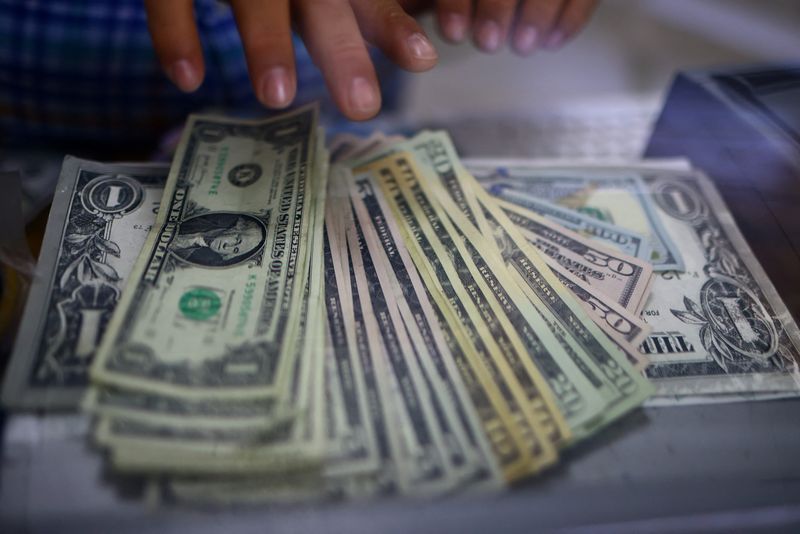Forex
Dollar nudges at two-week highs; yen grabs spotlight

By Saqib Iqbal Ahmed and Amanda Cooper
NEW YORK (Reuters) -The dollar hovered near a two-week high against the euro on Tuesday as traders braced for a data-heavy week, including Friday’s U.S. payrolls report that will could shape the path of interest rate cut from the Federal Reserve.
Investor focus this week will squarely be on the U.S. payrolls data after Fed Chair Jerome Powell last month endorsed an imminent start to interest rate cuts in a nod to concern over a softening in the labour market.
Economists surveyed by Reuters expect an increase of 165,000 U.S. jobs in August, up from a rise of 114,000 in July.
Ahead of that, job openings data on Wednesday and the jobless claims report on Thursday will be in the spotlight.
A gauge of U.S. manufacturing edged up last month from an eight-month low in July amid improvement in employment, but the overall trend continued to point to subdued factory activity, data on Tuesday showed.
The euro was 0.3% lower against the dollar at $1.1043 on Tuesday, after slipping to a two week low of $1.103375 earlier in the session.
“We may see some intraday volatility before the jobs print, akin to what we’re seeing today as U.S. participants return from Labor Day, though I think most participants will be seeking to keep their powder dry ahead of the main event at the tail end of the week,” Michael Brown, senior research strategist at Pepperstone, said.
Markets are pricing in a 69% chance of a 25 basis points (bps) cut when the Fed meets on Sept. 17 and 18, with a 31% probability of a 50-bps cut, CME FedWatch tool showed. Some 100 bps of cuts are priced in all for the year.
AUGUST SLIDE
Incoming data will also offer clues to whether the dollar’s August slide was overdone or whether more losses are in store for the buck.
“A weaker jobs report would likely drive the dollar lower,” Fawad Razaqzada, Market Analyst at StoneX, said in a note.
The Dollar Index, which measures the U.S. currency’s strength against six major peers, fell 2.2% in August, its worst monthly showing since November. On Tuesday, the index was up 0.14% at 101.80.
The dollar fell 1% against the yen on Tuesday to 145.51 yen after media reports cited the Bank of Japan governor reiterating in a document submitted to a government panel on Tuesday that the central bank would keep raising interest rates if the economy and inflation performed as policymakers currently expect.
Japan’s yen has staged a 10% rally in the last two months – aided in part by official intervention.
“The governor of the Bank of Japan wrote a letter to the Japanese government, explaining the decision to raise rates in July. He also said that the BOJ will continue to raise interest rates ‘if the economy and prices perform as expected’,” XTB research director Kathleen Brooks said.
“The yen is higher on the back of these comments,” she said.
The pound eased against the dollar on Tuesday as investors booked some profit on sterling’s August rally, its largest monthly gain in 10 months. The British currency was last down 0.4% at $1.30965.

The firmer U.S. dollar weighed on the Australian and New Zealand dollars, which fell on Tuesday after ending August with hefty gains.
The was down 1.1% while was 0.82% lower.

 Forex3 years ago
Forex3 years agoForex Today: the dollar is gaining strength amid gloomy sentiment at the start of the Fed’s week

 Forex3 years ago
Forex3 years agoUnbiased review of Pocket Option broker

 Forex3 years ago
Forex3 years agoDollar to pound sterling exchange rate today: Pound plummeted to its lowest since 1985

 Forex3 years ago
Forex3 years agoHow is the Australian dollar doing today?

 Cryptocurrency3 years ago
Cryptocurrency3 years agoWhat happened in the crypto market – current events today

 World3 years ago
World3 years agoWhy are modern video games an art form?

 Commodities3 years ago
Commodities3 years agoCopper continues to fall in price on expectations of lower demand in China

 Economy3 years ago
Economy3 years agoCrude oil tankers double in price due to EU anti-Russian sanctions



























